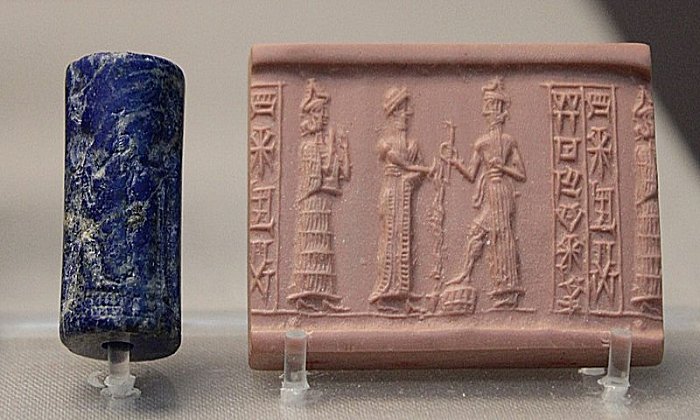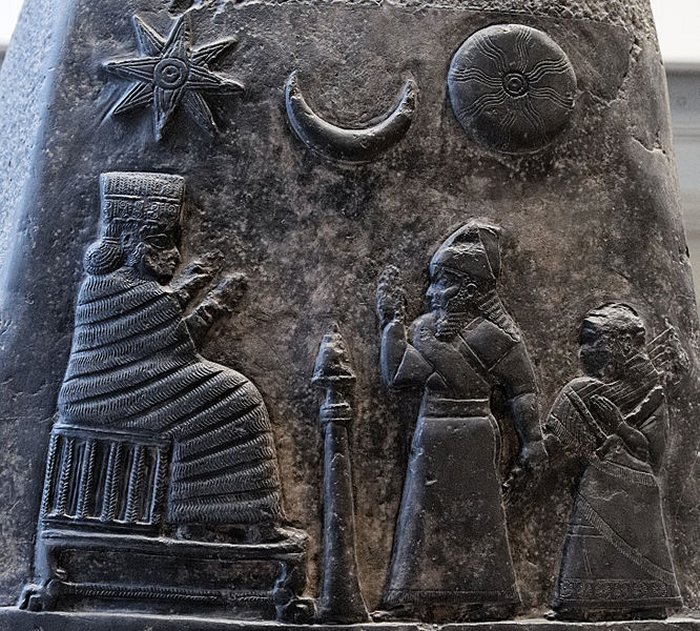Shamash: Mesopotamian God Of Sun, Truth, Justice And Healing
Ellen Lloyd - AncientPages.com - Shamash was the Sun god in the mythology of the ancient Near East. He was associated with truth, justice, and healing and was one of the most active gods in the pantheons of ancient Sumer, Babylonia, and Assyria. In Sumer, he was worshipped as god Utu.
Lapis lazuli cylinder seal. A suppliant goddess (left, with necklace counterweight) stands behind the robed king (center) who pours libation before the ascending sun god who holds the rod and ring of justice and rests his foot on a rectangular chequer-board mountain. Bur-Dagan, son of Kurub-Adad, inscribed on the seal, is probably the name of the owner. From a tomb in Ur, dated c. 1900 BC. BM 121418. Image credit: Zunkir - CC BY-SA 4.0
Shamash was the judge of gods and men
As a powerful solar deity, Shamash, whose consort was the goddess Aya, exercised the power of light over darkness and evil. In this capacity, he became known as the god of justice and equity and was the judge of both gods and men. At night, Shamash became the judge of the underworld.

Mesopotamian limestone cylinder seal and impression: worship of the sun god, Shamash, (Louvre Museum). Image credit: Jastrow - Public domain
Shamash was also regarded as a god who released sufferers from the grasp of demons. The sick appealed to Shamash as the god who can be depended upon to help those who are suffering unjustly. This aspect of Shamash is vividly brought out in hymns addressed to him.
In some cases, Shamash was seen as governing the entire universe and was pictured as a king on his royal throne with his staff and signet ring.
According to legend, the Babylonian king Hammurabi received his code of laws from Shamash.
The Hammurabi codes are some of the earliest and most complete ancient legal codes proclaimed by the Babylonian king Hammurabi, who reigned from 1792 to 1750 BC.
Shamash is depicted as overcoming darkness and death. In the Epic of Gilgamesh, he assisted in the conquest of the monster Humbaba, guardian of the deep forests of Lebanon.
Shamash worship and temples
Shamash was widely worshipped in the ancient near East. The chief centers of his cult were at Larsa, represented by the modern Senkerah in Sumer, and at Sippar, represented by the mounds at Abu Habba in Akkad.
Kudurru (stele) of King Melishipak I (1186–1172 BC): the king presents his daughter to the goddess Nannaya. The crescent moon represents the god Sin, the sun the Shamash and the star the goddess Ishtar. Image credit: Jastrow - Public domain
Temples dedicated to Shamash were also erected in all large population centers, including Babylon, Ur, Mari, Nippur, and Nineveh. Shamash's major temples were located at Sippar and Larsa.
In Canaanite tradition, the Sun god was Shemesh, the "torch of the gods," but was described as female. The worship of Shemesh/Shamash was also practiced among the Israelites, although it was forbidden by the prophets and biblical writers.
Shamash journey through the heavens in his chariot
Shamash, who was the brother of the goddess Ishtar, is often pictured with a disk that symbolizes the Sun. Like the later Apollo, he made his daily journey through the heavens, either on horseback, in a chariot, or on a boat. Together with Sin and Ishtar, Shamash formed a triad of gods that completed the even older trinity of Anu, Enlil, and Ea, representing the heavens, earth, and water, respectively. The three powers of Sin, Shamash, and Ishtar symbolized three great forces of nature: The sun, the moon, and the morning star (or love and fertility).
Tablet of Shamash
Shamash's symbol appears on numerous artifacts found in the Near East, including jewelry, cylinder seals, and other objects. One famous example, dating to the 9th century BCE and known simply as the "Tablet of Shamash", is currently housed in the British Museum.
Relief image on the Tablet of Shamash, British Library room 55. Found in Sippar (Tell Abu Habbah), in Ancient Babylonia; it dates from the 9th century BC and shows the sun god Shamash on the throne, in front of the Babylonian king Nabu-apla-iddina (888-855 BC) between two interceding deities. The text tells how the king made a new cultic statue for the god and gave privileges to his temple. Image credit: Prioryman - source
The Tablet of Shamash is a stone tablet recovered from the ancient Babylonian city of Sippar in southern Iraq in 1881. The tablet has serrated edges like a saw, which was the symbol of both Shamash and Saint Simon Zelotes in later traditions. The bas-relief on the top of the obverse shows Shamash, the Sun God, beneath symbols of the Sun, Moon, and Venus. He is depicted seated in a shrine, holding forward a measuring rod and reel of the cord. There is another large sun disk in front of him on an altar, suspended from above by two figures.
There is no doubt that Shamash was a very important deity in the Near East.
Updated on March 29, 2024
Written by Ellen Lloyd - AncientPages.com
Copyright © AncientPages.com All rights reserved. This material may not be published, broadcast, rewritten or redistributed in whole or part without the express written permission of AncientPages.com
Expand for referencesMore From Ancient Pages
-
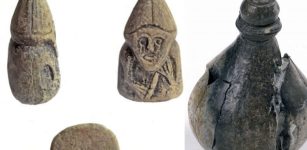 Old Norse Settlers Traded Walrus Ivory With Kyiv – Spectacular Archaeological Finds Reveal
Archaeology | Jun 16, 2022
Old Norse Settlers Traded Walrus Ivory With Kyiv – Spectacular Archaeological Finds Reveal
Archaeology | Jun 16, 2022 -
 Climate In The Andes Has Driven 7,000 Years Of Dietary Changes – New Study Reveals
Archaeology | Feb 9, 2022
Climate In The Andes Has Driven 7,000 Years Of Dietary Changes – New Study Reveals
Archaeology | Feb 9, 2022 -
 Bronze Age Long-Distance Connections: Baltic Amber In Aššur
Archaeology | May 17, 2023
Bronze Age Long-Distance Connections: Baltic Amber In Aššur
Archaeology | May 17, 2023 -
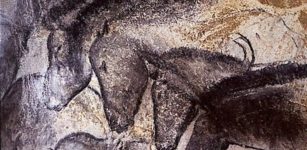 Prehistoric Artwork In Chauvet-Pont d’Arc Cave 10000 Years Older Than Previously Thought
Archaeology | Apr 12, 2016
Prehistoric Artwork In Chauvet-Pont d’Arc Cave 10000 Years Older Than Previously Thought
Archaeology | Apr 12, 2016 -
 On This Day In History: Great Fire Of Rome Recorded – On July 18, 64 AD
News | Jul 18, 2016
On This Day In History: Great Fire Of Rome Recorded – On July 18, 64 AD
News | Jul 18, 2016 -
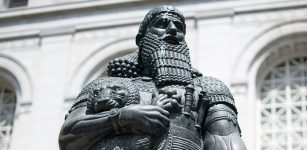 Ashurbanipal – Last Great Ruler Of Assyria And His Famous Well-Organized Library
Featured Stories | Jun 21, 2021
Ashurbanipal – Last Great Ruler Of Assyria And His Famous Well-Organized Library
Featured Stories | Jun 21, 2021 -
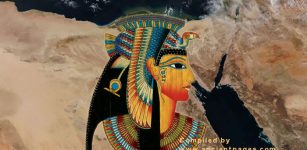 Effects Of The Volcanic Eruption In Alaska Rippled Through Ancient Egypt During Cleopatra’s Reign
Archaeology | Jul 26, 2022
Effects Of The Volcanic Eruption In Alaska Rippled Through Ancient Egypt During Cleopatra’s Reign
Archaeology | Jul 26, 2022 -
 Mysterious Viking Burial Site Of Three Women In Norway Reveals Its Secrets
Vikings | Dec 26, 2024
Mysterious Viking Burial Site Of Three Women In Norway Reveals Its Secrets
Vikings | Dec 26, 2024 -
 2,000 Years Ago Mysterious Foreigner With Unique Ancestry Traveled To Cambridgeshire – Who Was He?
Archaeology | Dec 27, 2023
2,000 Years Ago Mysterious Foreigner With Unique Ancestry Traveled To Cambridgeshire – Who Was He?
Archaeology | Dec 27, 2023 -
 Neanderthal-Denisovan Ancestors Interbred With ‘Superarchaic’ Population 700,000 Years Ago
Archaeology | Feb 24, 2020
Neanderthal-Denisovan Ancestors Interbred With ‘Superarchaic’ Population 700,000 Years Ago
Archaeology | Feb 24, 2020 -
 Mysterious Kaali Crater And The Holy Lake – Sacred Ancient Places In Estonia
Featured Stories | Jan 19, 2018
Mysterious Kaali Crater And The Holy Lake – Sacred Ancient Places In Estonia
Featured Stories | Jan 19, 2018 -
 Paititi: Legendary Lost Inca City Of Gold Built By The Inca Hero Inkarri
Featured Stories | Mar 16, 2016
Paititi: Legendary Lost Inca City Of Gold Built By The Inca Hero Inkarri
Featured Stories | Mar 16, 2016 -
 Sir Francis Walsingham: Spymaster, Politician And Trusted Adviser To Queen Elizabeth I
Featured Stories | Nov 25, 2019
Sir Francis Walsingham: Spymaster, Politician And Trusted Adviser To Queen Elizabeth I
Featured Stories | Nov 25, 2019 -
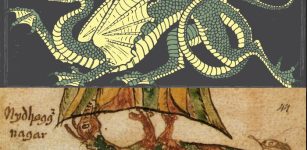 Nidhogg – Dreadful Winged Corpse-Eating Dragon Who Is Enemy Of Asgard And Yggdrasil Tree
Featured Stories | May 9, 2020
Nidhogg – Dreadful Winged Corpse-Eating Dragon Who Is Enemy Of Asgard And Yggdrasil Tree
Featured Stories | May 9, 2020 -
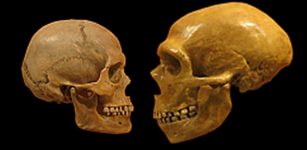 Neanderthals Had Capacity To Speak And Understand Language Like Humans
Archaeology | Mar 2, 2021
Neanderthals Had Capacity To Speak And Understand Language Like Humans
Archaeology | Mar 2, 2021 -
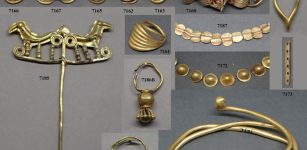 Mystery Of The Gold From Troy, Poliochni And Ur Solved!
Archaeology | Dec 2, 2022
Mystery Of The Gold From Troy, Poliochni And Ur Solved!
Archaeology | Dec 2, 2022 -
 Mystery Of The Patagonian Giants: Europe’s Lost Race From The ‘Land Of The Bigfeet’
Featured Stories | Jun 20, 2020
Mystery Of The Patagonian Giants: Europe’s Lost Race From The ‘Land Of The Bigfeet’
Featured Stories | Jun 20, 2020 -
 Dozens Of Unique 2,500-Year-Old Ceremonial Treasures Discovered In A Drained Peat Bog
Archaeology | Jan 27, 2023
Dozens Of Unique 2,500-Year-Old Ceremonial Treasures Discovered In A Drained Peat Bog
Archaeology | Jan 27, 2023 -
 Unusual Ancient Spider Pipes Of Tennessee – Were They Used By Shamans To Enter The Spirit World?
Artifacts | Feb 18, 2018
Unusual Ancient Spider Pipes Of Tennessee – Were They Used By Shamans To Enter The Spirit World?
Artifacts | Feb 18, 2018 -
 DNA Reveals Unique Ancestry Of Inhabitants Of The Angolan Namib Desert
DNA | Oct 3, 2023
DNA Reveals Unique Ancestry Of Inhabitants Of The Angolan Namib Desert
DNA | Oct 3, 2023

